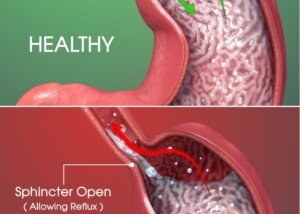Pain in the upper right abdomen can be from GERD, though this isn’t one of the more likely causes of discomfort in this area.
If you’re familiar with human anatomy, you’ll know that the lower esophageal sphincter – the ring-like muscle at the junction of the stomach and bottom of the esophagus – is slightly left of the center of your chest.
The esophagus then runs up the center of your chest, which is why acid reflux so commonly causes a burning or uncomfortable sensation beneath the sternum (breastbone).
GERD can also cause a discomfort or burning in the upper abdomen, but usually it’s in the middle.
So how could GERD cause pain in the upper right abdomen?
In fact, the patient may have GERD pain only in the upper right abdomen.
“Pain, especially pain arising from the gastrointestinal tract, is a highly subjective phenomenon,” says Santosh Sanagapalli, MD, a consultant gastroenterologist, endoscopist and specialist in esophageal disorders.
“The same pain stimulus can elicit different severity, location and intensities of pain in different patients.
“Common to gastrointestinal syndromes is the concept of referred pain, where pain may often be felt at a location distant to the actual location of the organ.”
Two classic examples of referred pain are heart attack and rotator cuff injury.
In a heart attack, the pain may be felt in the jaw or left arm. Rotator cuff pain is often felt in the side of the upper arm, even though none of the rotator cuff tendons are located there.
GI pain, as well, can be referred.
“This occurs because the pain fibers supplying the deep internal organs are actually quite poor at localization and are shared amongst several internal organs,” says Dr. Sanagapalli.
“Further, the anatomy of the nervous system responsible for sensing pain can be highly variable between patients.
“In most patients, esophageal pain (from GERD or other causes) is sensed in the chest, behind the breastbone.
“However, in some patients, the same esophageal problem could be felt as pain in the upper abdomen, either central (more common) or on the right side (less common).
“Presumably, this is because of variability of the pain-sensing fibers in these patients.”
Another way of understanding this is to close your eyes and have someone pinch your arm without telling you where they’re doing it.
You’ll know precisely where they are pinching. This is because the pain nerves in the arm are pretty good at communicating messages to your brain.
But if there’s pain somewhere in your esophagus due to repeated contact with acid, the sensory nerves aren’t as accurate at relaying information.
“However, right upper quadrant abdominal pain is a very uncommon manifestation of GERD,” says Dr. Sanagapalli, “and before making this diagnosis, other more common causes should be ruled out, especially gallstones, liver or pancreatic conditions.”
 Dr. Sanagapalli is a gastroenterologist and director of the Esophageal Disorders Center at St Vincent’s Hospital, Darlinghurst. He performs diagnostic and therapeutic endoscopic procedures, and enjoys providing comprehensive and holistic care to patients with a wide variety of disorders affecting the gastrointestinal tract.
Dr. Sanagapalli is a gastroenterologist and director of the Esophageal Disorders Center at St Vincent’s Hospital, Darlinghurst. He performs diagnostic and therapeutic endoscopic procedures, and enjoys providing comprehensive and holistic care to patients with a wide variety of disorders affecting the gastrointestinal tract.
 Lorra Garrick has been covering medical, fitness and cybersecurity topics for many years, having written thousands of articles for print magazines and websites, including as a ghostwriter. She’s also a former ACE-certified personal trainer.
Lorra Garrick has been covering medical, fitness and cybersecurity topics for many years, having written thousands of articles for print magazines and websites, including as a ghostwriter. She’s also a former ACE-certified personal trainer.
.



























